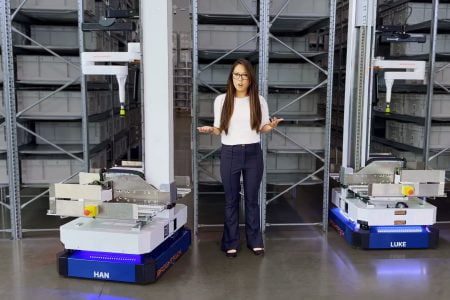How automated order consolidation, staging and buffer helps warehouses improve fulfillment efficiency at dispatch
As consumer demand changes, companies are looking for flexible automation to consolidate, buffer and stage orders before dispatch. Mobile robots offer a fast and scalable way to improve fulfillment efficiency compared to traditional buffer solutions like conveyor or shuttles.

Improving picking efficiency has been a top priority for warehouses in recent years, and rightly so. Order picking is highly labor and cost-intensive, which is why robotic picking systems are cited as the #1 focus area for companies looking to automate within the next three years. However, picking is just part of the equation. For executives, operators, and engineers looking to improve overall warehouse performance, optimizing what happens after the pick can be just as important as the pick itself.
One of the most labor-intensive warehouse processes outside of order picking is order consolidation, staging and buffer. Distribution centers that need to build large orders, which consist of multiple totes or small cases, need to consolidate those orders before dispatch. Additionally, some warehouses need to consolidate orders picked across multiple different picking zones within their warehouse, for example ambient and chilled.
Having to consolidate and stage orders before dispatch adds complexity, labor and additional human touches for a warehouse operation. Managed poorly, it can become a bottleneck for the fulfillment process, even if the picking process itself is highly optimized and automated.
Robotic order staging and consolidation enables companies to simplify operations and get rid of chaotic manual sortation or costly conveyor systems in favor of neatly orchestrated robotic workflows. The robots consolidate totes and cases into complete orders and deliver them according to the exact route profile and delivery schedule each driver needs. In addition, the robots can store picked orders in a temporary buffer area until they need to be dispatched, which enables warehouses to pick orders in advance and dispatch more orders during peak hours.
Companies such as Rohlik Group, one of Europe’s largest e-grocers, use mobile robots to automate order staging and boost performance of their existing AS/RS picking systems:
There are several benefits to using robots for order staging, consolidation and buffer:
- Warehouses can dispatch more orders during peak hours by picking and buffering them in advance
- Customer satisfaction is improved and return rates are reduced by eliminating human error
- Orders are always shipped on time and late shipment fees are avoided as robots can easily adapt to changing shipping schedules, route profiles or order prioritization
- Fulfillment costs are reduced as less labor is required for warehouse dispatch
- Companies can buffer and fulfill more orders without growing their warehouse footprint with the help of high-density buffer storage
Optimizing order consolidation, staging and buffer is critical for any warehouse picking large order sizes or managing multiple picking zones. Medical distributors, grocers, convenience stores, pharmacies, manufacturers and restaurant and catering suppliers are increasingly installing automated buffer and dispatch solutions such as Brightpick Dispatcher in their warehouses. Learn more about it here.
Ready to embrace the future of fulfillment? Learn more about Brightpick and how our AI robots can optimize your operations.
Get started with Brightpick

